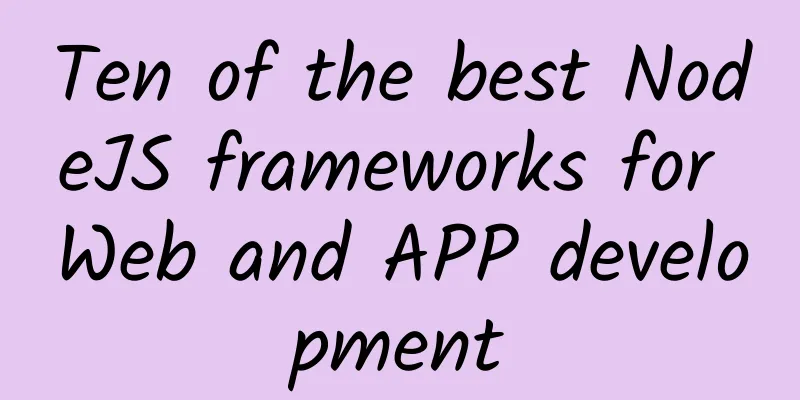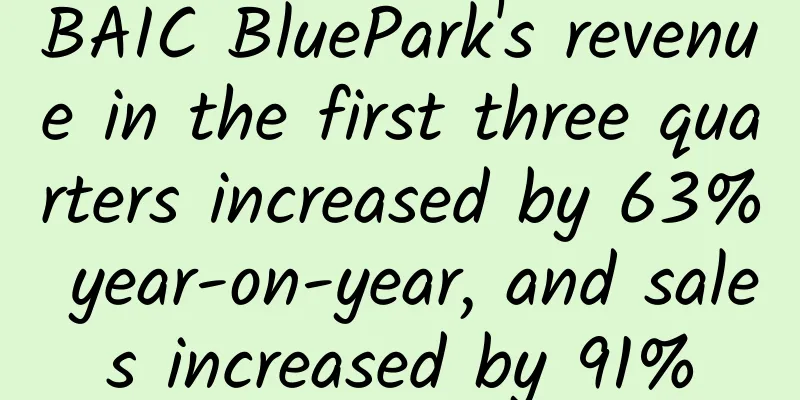Ten of the best NodeJS frameworks for Web and APP development

|
Running JavaScript outside the browser is amazing for JavaScript enthusiasts and is certainly one of the biggest advancements in web application development. Developers around the world are embracing NodeJS with open arms. For the uninitiated, Node.js is a JavaScript runtime that allows you to run JavaScript code on a server outside of a browser. It is built on top of Google Chrome's V8 virtual machine engine, which is used to power JavaScript in the Chrome browser. NodeJS is gaining popularity because it allows you to build large-scale, real-time, scalable mobile and web applications using only JavaScript. As the node ecosystem grows, frameworks have also started to speed up the workflow. There are many Node.js frameworks that allow you to build real-time end-to-end network applications without any other third-party web servers, application servers, tools, and technologies. The general Node framework is like express delivery, Koa and Hapi are more flexible, allowing you to do everything you want and meet development needs to the maximum extent. However, you need to put in more effort at the beginning and rely more on developers to make the right decisions. On the other hand, frameworks like Mean.io, Meteor, Derby and Mojito have their own standard structures and technical systems, which are less flexible. However, these frameworks will not give developers too much room to make wrong decisions. Let's take a look at the newest and largest NodeJS framework available today and help you build real-time, scalable web applications of various sizes and complexities. 1. Node.js ExpressFor a developer who has already used node.js, Express or "node.js express" is not a new thing. The Express framework provides a better encapsulation of the node.js native API, making it easier for developers to use node.js. The Express framework provides all the features for developing robust web/mobile applications and APIs. Developers can also easily develop plugins and extensions for it to increase the capabilities of Express. Here are some of the basic features provided by Express:
By using Node Express, you can use less code to implement functions. At least by using Node Express, you can implement middleware to respond to http requests, define routing tables to define response functions for different requests, and use template engines to output html pages. For a NodeJS developer newbie, Express also provides the following benefits:
Express is open source under the MIT protocol and is currently supported by StrongLoop. You can also get more information from the official website of Express at expressjs.com. 2. Sails.js (node.js mvc)Sails is a very solid nodejs framework that provides all the features needed to build web applications of any size. Sails.js uses the express framework at the bottom layer to provide processing for http requests, and uses the Socket.IO framework to process WebSocket requests. At the same time, as a front-end application development framework, it allows developers to choose the technology he/she is familiar with to develop applications. At the same time, Sails.js also implements ORM function through the waterline framework. With this function, your application can switch from one backend database to another (it can also be a NoSQL database) without major modifications. Sails is particularly suitable for developing applications that have high requirements for real-time data updates, such as multiplayer chess games, single-page web applications, etc. If you have a certain understanding of Ruby, Django or Zend, then it will be very easy for you to understand the concepts in Sail. In short, Sails.js provides developers with an excellent MVC framework and a certain degree of flexibility, allowing developers to choose the front-end development method and the back-end database. Sails.js was created by Mike McNeil and is now supported by Treeline and balderdash. Sails.js is open source under the MIT protocol. You can find out more about the framework at sailsjs.org. 3. KOAKOA is a rising star in the node.js MVC framework, and its first version was released in the fourth quarter of 2013. The developers of KOA are basically from the Express development team, and TJ Holowaychuk is the leader of the KOA development team. Although most of the developers of KOA come from Express, they use completely different technologies to develop KOA, and KOA is becoming a strong competitor of Express. The core of the KOA framework is the ES6 generator. KOA uses generators to implement middleware flow control and use try/catch to enhance exception handling. At the same time, you will no longer see complex callbacks in the KOA framework. The KOA framework itself is very small and only packs some necessary functions, but it has a good modular organization, allowing developers to implement a very scalable application according to their own ideas. Many loyal JavaScript/Node.js developers have begun to choose to use KOA to develop new projects because KOA provides more flexibility in developing applications. You can get more information at koajs.com. 4. MeteorMeteor framework is the best full-stack framework for Node.js. The project has 28K+ likes on GitHub, a large number of custom packages, huge community support, and very good tutorials and documentation. Meteor is undoubtedly the king in this field. You can use it to build real-time web and mobile applications in pure Javascript. The best part of Meteor is that all processes are seamlessly connected and ready to use, whether it is server-side database access, business logic implementation, or client-side display. The entire framework uses a unified API, and the Meteor API is applicable to both the client and the server. The DDP protocol it uses allows you to connect to simple database services, enterprise data warehouses, and even IOT sensors on the back end. Meteor comes with its own default stack, but is flexible enough to allow you to choose your own technical solution. If you don't need to try other frameworks or have no other restrictions, you can directly use the default configuration for rapid application development. Meteor has a professional development team and a large amount of financial support from large venture capitals, which enables Meteor to always stay ahead in the industry. You can learn more about Meteor at meteor.com. 5. Derby.jsDerby.JS is a full-stack framework like its direct competitors Meteor, Mean.io, and Mojito. It runs on top of Nodejs + mongo + Redis. The main part of Derby is a data synchronization engine called Racer, which makes it easy to synchronize data between databases, servers, and browsers. Racer can indeed make applications based on the Derby framework run faster, whether in the browser or on the server, it is a great choice for single-page applications. Derby is often compared with the industry leader Meteor, which has been developed for a long time and can provide more out-of-the-box features, making it easier to develop complex web applications in a shorter time. Derby is more suitable for applications that need to run faster, and its modular approach can make applications more flexible and easier to expand. Derby's recent development has been a bit slow, but it is not out of the game and still has the potential to rewrite the rules of the Nodejs full-stack framework game. You can learn more about Derby at derbyjs.com. 6. Flatiron.js (Node.js MVC framework)The core idea behind the Flatiron framework is that you can build your own full-stack framework using the components it provides and some third-party libraries. Pretty cool, right? I personally like this approach a lot. However, it comes with a higher level of complexity and the potential for developers to mess up by using the wrong components. You can call it a full-stack MVC framework that is loosely built from multiple independent components. The Flatiron framework supports Director, a URL routing component that is built from the ground up using JavaScript and does not require any dependencies. Through a template engine called Plates, Flatiron can support template languages, while data management is implemented through json and can be used with any database. Flatiron is now maintained by Nodejitsu and other community members, and it is a less popular framework but worth a look. You can get more information at flatironjs.org. 7. HapiHapi is one of the few node.js frameworks that does not depend on Express, and is now completely independent of Express. In recent times, many developers have chosen Hapi instead of Express, making it more or less a competitor to Express. Hapi is not a veteran among many nodejs frameworks, but it has successfully created its own ecosystem. Hapi is committed to completely separating the node HTTP server, routing and business logic, and focusing more on how to control things as much as possible through configuration rather than code. Hapi was originally developed by Eran Hammer and his team at Walmart labs for work needs. It has since gained popularity at an extremely fast rate and is now an open source framework under the MIT license, free to download and use. Companies like Disney, Yahoo, Pebble, Beats Music, and Walmart are using HAPI as a web application framework for one or more of their projects, and its influence is evident. You can find more information about Hapi at hapijs.com. 8. Mean.IOMean is a combination of Mongo DB, Express, Angular and Node.js bundled together. Basically, with it, you have a complete set of tools for the database layer, server side and web front end, enough to develop all types of modern network applications. Mean is a complete standalone package that covers all aspects of application development. It is especially suitable for those who need to start development quickly. It has multiple technologies built in and performs very well when used together. It can be used to create applications of any size and complexity. With Mean, developers can avoid the hassle of mixing and matching different technology stacks. With the mean stack, you can reduce the time required to install and configure MongoDB, Express, Angular, and Node.js. Another great benefit of Mean.io is that the entire stack uses JavaScript, with server-side Express access to MongoDB (json) and Node to the client via Angular. Learn more about Mean.io here - mean.io There is also a fork of mean called mean.js which is quite popular. 9. MojitoMojito was developed by Yahoo and became an instant success, but soon it became a stand-alone framework, just like Meteor and Mean stack. Mojito is also an MVC application framework that is very suitable for creating high-performance web and mobile applications using HTML5, JavaScript and CSS3. The fundamental goal of Mojito is to provide a framework for building standard cross-platform applications that can run on both the client and the server and achieve high performance. You can get more information at the Yahoo Developers page - mojito. 10. Socket StreamSocketStream is an interesting framework that focuses on fast synchronization of client and server data. It is dedicated to real-time updates of front-end and back-end data. Its biggest feature is that it does not strictly require you to use a specific client technology, nor does it limit the database ORM. I tend to compare it with its brother project Sail.js, which has the same function. It is more suitable for single-page web applications, multi-user games, chat clients, network applications, trading platforms, and all applications that need to push data from the server to the client in real time. The server and client use JSON to transfer data. It is ideal to use websockets to automatically push data to the client when server events occur. Socket stream was created by Owen Barnes and is now maintained by Paul Jensen and his team. Their work has given this framework the glory it deserves. The SocketStream framework has seen great development in recent months and has a very bright future. For more information about SocketStream, please visit - socketstream on github. Other similar excellent frameworks include: total.js, Geddy.JS, Locomotive, compound and Restify. in conclusionThe landscape of web and application development is changing very fast, with developers moving towards fast frameworks and clean project delivery. The biggest advantage of using a node framework is that it provides a high-level structure out of the box, so you can focus on scaling your application rather than spending effort on building it. Frameworks offer a variety of features, work at different levels, and try to solve common problems in building real-time, scalable and complex web applications at speed. The frameworks discussed in this article are the most popular node.js frameworks in the market today. |
<<: Anchang Liu Xin: How to solve the problem of overseas game operation
>>: HTML5 Game Engine In-depth Review
Recommend
The Ministry of Industry and Information Technology has issued a list of apps that infringe on user rights, including QQ, 12306, etc.
On December 19, according to the website of the M...
I loved wearing high heels when I was young, but now I have to have my bones cut off! Do you still dare to wear them after reading this?
"Give a woman a pair of high heels, and she ...
Gently awaken the "sleeping" seeds
Forage seeds: a bridge between ecology and animal...
In addition to Google, they are also developing driverless technology
At Google's I/O Global Developer Conference, ...
How to operate an event? Share 4 tips!
To operate product activities well, we must not o...
There is actually a Mars-like area on Earth. Where is it?
Apart from Earth, which planet is most familiar t...
Tech Neo Technology Salon No. 16 - Automated Operation and DevOps
【51CTO.com original article】 [51CTO original arti...
Electric Technology Car News: Exquisite appearance and perfect endurance, this electric car brings hope to the EV industry
It is said that young people like to follow fashi...
Tips for choosing advertising channels!
As of today in 2020, with the rapid rise and matu...
Does WeChat Mini Program belong to the front end?
Does WeChat Mini Program belong to the front end?...
After Baidu, Alibaba also talked about mini-programs as an “operating system”, but openness cannot be just talk.
The "open" competition trend of mini pr...
10 apps removed from shelves by the Ministry of Industry and Information Technology! They are peeking at your photo albums
Last month, the Ministry of Industry and Informat...
How much does it cost to join a specialty product app in Fuzhou?
For entrepreneurs, although mini program developm...
How to write product and promotion copy for Double Eleven?
The annual large-scale shopping festival is comin...
Case + Tips | 5 steps to easily create high-conversion information flow advertising
In the past two years, information flow advertisi...









